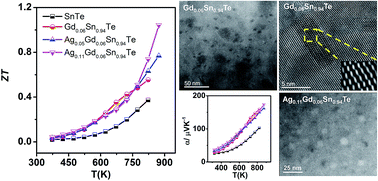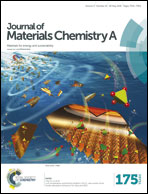Lead-free SnTe-based thermoelectrics: enhancement of thermoelectric performance by doping with Gd/Ag†
Abstract
SnTe, with the same rock-salt structure as PbTe, is a potentially attractive thermoelectric material. Pristine SnTe has poor thermoelectric performance because of its very high hole concentration resulting from intrinsic Sn vacancies, which leads to a high thermal conductivity and a low Seebeck coefficient. In this work, the thermoelectric properties of SnTe were modified by doping with different contents of gadolinium and silver. It is found that SnTe doped with optimal gadolinium (i.e. Gd0.06Sn0.94Te) exhibited extraordinarily low lattice thermal conductivity that is close to the theoretical minimum. The drastic reduction of lattice thermal conductivity is attributed to the formation of nanoprecipitates, which strongly scatter phonons by mass fluctuation between a second phase and matrix coupled with mesoscale scattering via grain boundaries. Further doping Gd0.06Sn0.94Te with Ag leads to a higher Seebeck coefficient due to the decreased carrier concentration and adjusted phase composition. Optimal Ag doping leads to a 3 times and 2 times enhancement of the figure of merit (ZT) in comparison with SnTe and Gd0.06Sn0.94Te, respectively, i.e. a ZT of ∼1.1 was obtained for 11 atom% Ag-containing Gd0.06Sn0.94Te at 873 K.


 Please wait while we load your content...
Please wait while we load your content...